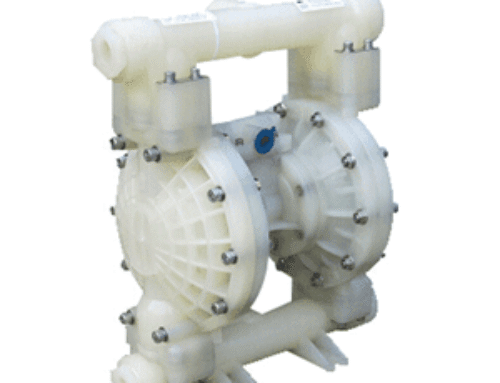The choice of pump head material determines how well a pump handles corrosion, temperature, and chemical attack. Since the pump head is the part that comes in direct contact with the fluid, choosing the wrong material can lead to leaks, rapid wear, or total failure. To ensure long service life and safe operation, the material must be compatible with the fluid’s chemical properties.
Below are eight common pump head materials, their fluid compatibility, and where they are typically used across industries.
1. PVC (Polyvinyl Chloride)
Compatible Fluids: Mild acids, alkalis, and water-based chemicals.
PVC is one of the most cost-effective and corrosion-resistant materials for general-purpose pumps. It performs well in applications involving neutral or slightly aggressive fluids, such as sodium hypochlorite, cleaning agents, and fertilizers.
Because of its light weight and ease of fabrication, PVC is widely used in water treatment, irrigation, and industrial cleaning systems. However, it has low temperature resistance and should not be used with strong solvents, hydrocarbons, or hot liquids. For low-cost, non-critical chemical dosing, PVC remains an efficient option.
2. PVDF (Polyvinylidene Fluoride)
Compatible Fluids: Strong acids, oxidizing agents, chlorinated chemicals, and solvents.
PVDF offers excellent resistance to corrosion, UV radiation, and high temperatures. It handles aggressive chemicals such as hydrochloric acid (HCl), sulfuric acid (H₂SO₄), and chlorine-based compounds without degradation.
This makes PVDF the preferred material for chemical processing, industrial wastewater treatment, and pharmaceutical production. It is stronger and more chemically stable than PVC but also more expensive. When long-term chemical durability is required, PVDF is one of the most dependable materials.
3. PTFE (Polytetrafluoroethylene / Teflon)
Compatible Fluids: Almost all chemicals, including strong acids, bases, oxidizers, and solvents.
PTFE has the broadest chemical compatibility of any pump head material. It is virtually inert, meaning it does not react with most substances, even at high temperatures. This makes it ideal for pharmaceutical, semiconductor, laboratory, and petrochemical environments.
PTFE can safely handle hydrofluoric acid, nitric acid, strong caustics, and organic solvents. It also resists sticking and buildup, making it ideal for handling viscous or adhesive fluids. The only drawback is that PTFE is less rigid than metals, so pump designs using it must account for dimensional stability.
4. SS316 Stainless Steel
Compatible Fluids: Non-corrosive fluids, oils, hydrocarbons, and mild acids.
SS316 is a high-grade alloy containing molybdenum, which increases corrosion resistance compared to standard stainless steel. It performs well in oil and gas, food processing, and industrial lubrication systems where both chemical resistance and mechanical strength are required.
This material can handle solvents, alcohols, and low-concentration acids, but it is not recommended for strong chlorides or hydrochloric acid, which can cause pitting corrosion. Its durability under high pressure and temperature makes it ideal for demanding process environments.
5. PP (Polypropylene)
Compatible Fluids: Organic acids, alkalis, detergents, and aqueous solutions.
Polypropylene is a tough, lightweight plastic known for its chemical and fatigue resistance. It is suitable for fluids like sodium hydroxide, acetic acid, and ammonia-based cleaners.
Commonly used in agriculture, chemical dosing, and wastewater treatment, PP provides a good balance of chemical stability and affordability. However, it should not be used with strong oxidizers (like nitric acid or hydrogen peroxide) or high-temperature liquids, as it can soften or warp.
6. Acrylic (PMMA / Polymethyl Methacrylate)
Compatible Fluids: Clear, non-aggressive liquids and light chemicals.
Acrylic is mainly used where visual inspection of the liquid path is needed, such as in laboratory or testing setups. It allows operators to observe the flow or detect bubbles inside the pump.
While it works well with water and mild solutions, acrylic is not recommended for use with solvents, acids, or high temperatures, as it can crack or discolor. It is chosen for its transparency, not for chemical durability.
7. Hastelloy C and Alloy 20
Compatible Fluids: Highly corrosive acids like sulfuric acid, hydrochloric acid, and chlorine-based solutions.
Hastelloy C and Alloy 20 are nickel-based alloys developed for extreme corrosion resistance. They can handle aggressive chemicals and oxidizing agents that would quickly damage stainless steel or plastics.
Used in petrochemical plants, acid recovery systems, and chemical reactors, these materials offer exceptional durability and stability under harsh conditions. Although they are expensive, they provide unmatched protection for high-risk chemical processes.
8. Aluminum / Anodized Aluminum
Compatible Fluids: Oils, non-corrosive liquids, lubricants, and light solvents.
Aluminum is strong, lightweight, and has good heat conductivity, making it suitable for automotive, lubrication, and fuel transfer systems. When anodized, its corrosion resistance improves, allowing it to handle a wider range of fluids.
However, aluminum should not be used with acidic or alkaline solutions, as it corrodes easily in such environments. It performs best with non-aggressive fluids where strength and portability are key.
Conclusion
Each pump head material offers distinct benefits and limitations depending on the fluid type and operating environment.
- For strong acids and solvents, use PTFE or PVDF.
- For water-based or alkaline solutions, PVC or PP is economical and sufficient.
- For hydrocarbons and lubricants, SS316 or aluminum provides strength and temperature tolerance.
- For extreme corrosion environments, Hastelloy C offers the highest protection.
Selecting the correct pump head material ensures not only chemical compatibility but also longer pump life, reduced maintenance, and safer operation across all industrial applications.





Leave A Comment